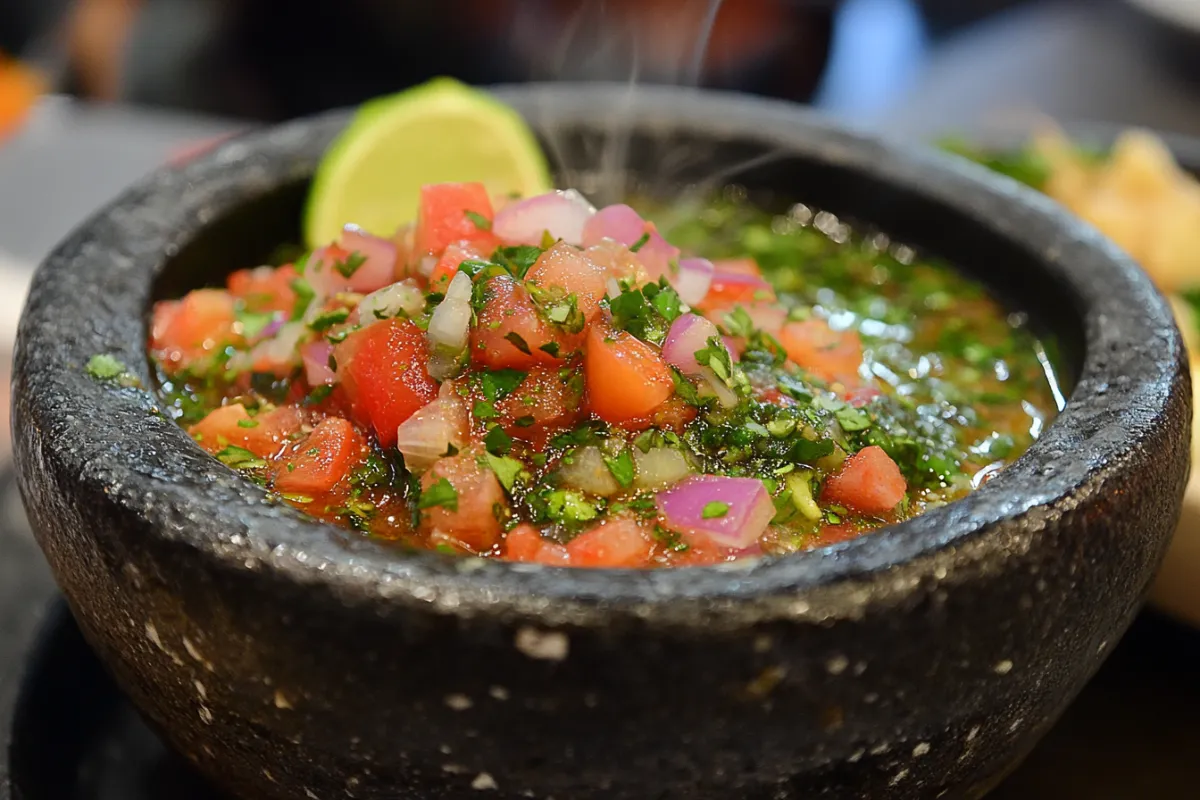The Comprehensive Guide to the Molcajete
The molcajete, a traditional Mexican mortar and pestle, has been a culinary staple for centuries. Made from volcanic rock, this ancient kitchen tool continues to play an essential role in Mexican cooking, helping to grind ingredients like spices, vegetables, and even meat. But beyond its practicality, this tool symbolizes a deeper connection to Mexico’s rich cultural heritage. In this guide, we’ll explore the origins, uses, types, and care tips for this iconic kitchen tool. We’ll also dive into some classic recipes that highlight its unique ability to bring out deep, bold flavors in food. Whether you’re new to this timeless device or seeking to elevate your cooking game, this traditional kitchenware is an investment worth considering. Explore other traditional culinary tools that have stood the test of time.
What is a Molcajete?
The molcajete is a stone mortar used for grinding ingredients, traditionally made from volcanic basalt rock. It’s paired with a pestle called a tejolote, which helps crush and grind foods into a paste or powder. The rough surface of the rock mortar creates friction, making it more effective than modern gadgets like blenders.
Materials and Design
Volcanic rock is the preferred material for this type of mortar due to its durability and porous texture. The rough surface grinds spices and vegetables much finer than smooth, modern mortars. The shape is typically bowl-like, with a sturdy base that allows it to sit comfortably on countertops without sliding.
Historical Significance
This traditional Mexican mortar has its roots in Mesoamerican civilizations such as the Aztecs and Mayans. It was used to grind cacao, corn, and spices, adding depth and flavor to meals. As a cultural symbol, the molcajete represents Mexico’s enduring connection to its culinary history. For more insight into how ancient tools like this shape the flavors of traditional dishes, read this guide on the benefits of traditional cooking methods.
How to Use a Molcajete
If you’ve just purchased this traditional kitchen tool, the first step is seasoning or curing it. This process removes impurities and dust from the rock and prepares the surface for use. Here’s how to get it ready for your kitchen.
Seasoning Your Molcajete
Start by rinsing the rock mortar under running water to remove any loose particles. Place a handful of uncooked rice in the bowl and use the tejolote to grind it into a fine powder. The goal is to have the rice absorb any remaining rock dust. Repeat this grinding process until the rice powder comes out completely clean. Once done, rinse again and let it air dry.
Using the Molcajete for Grinding
Once seasoned, this traditional kitchen tool is ready for use. Its rough surface is ideal for grinding spices, making salsa, or preparing guacamole. Unlike blenders, which can heat ingredients and alter their flavors, this mortar’s texture enhances the natural oils in foods, resulting in richer, more intense flavors.
Popular Recipes Using a Molcajete
Guacamole is a classic example of a dish that benefits from this traditional kitchen tool. Mash avocados with salt and lime juice, then mix in onions, tomatoes, and jalapeño. The texture of this kitchenware gives guacamole a chunky, yet smooth finish that’s hard to replicate with a fork or blender. Salsa molcajeteada is another popular recipe. Roasting tomatoes, onions, and chiles before grinding them together with garlic and salt results in an authentic salsa that’s more flavorful than one made in a food processor. For a detailed recipe on how to make traditional salsa, check out this authentic molcajete recipe.
The Cultural Importance of the Molcajete
This traditional kitchen tool holds deep cultural significance in Mexico. It’s often passed down through generations as a family heirloom. In rural Mexican communities, crafting a mortar like this remains a respected art. Artisans, known as canteros, hand-carve each piece from volcanic rock using traditional methods.
Symbol of Tradition
For many families, this kitchenware represents a connection to their ancestors and the traditional Mexican way of cooking. Its presence in the kitchen serves as a reminder of the rich culinary traditions that have been preserved for centuries.
The Molcajete in Modern Kitchens
Today, this stone mortar isn’t just confined to traditional Mexican kitchens. Professional chefs and home cooks worldwide use this tool to enhance their cooking. Its ability to unlock deep flavors makes it a favorite among gourmet chefs who want to add authenticity and boldness to their dishes. To learn more about the impact of ancient cooking tools like this one, you can read about the cultural significance of traditional culinary methods.
Types of Molcajetes
There are different types and sizes of this traditional Mexican kitchen tool to fit various kitchen needs. Understanding these differences can help you choose the right one for your cooking style.
Traditional Molcajetes
Handcrafted versions of this mortar are made by artisans who carefully carve each piece from volcanic rock. Handcrafted models are generally more durable and have a coarser texture, making them perfect for grinding tougher ingredients. In contrast, mass-produced molcajetes may have a smoother surface and are often less durable, though they are usually more affordable.
Sizes of Molcajetes
These mortars come in various sizes, ranging from small molcajetes chicos to larger models suitable for family-style cooking. The smaller versions (around 7 inches) are ideal for single servings or small families, while standard sizes (9-10 inches) are better suited for preparing larger batches of guacamole or salsa, making them perfect for entertaining guests.
Choosing the right size depends on your cooking needs. For smaller tasks like grinding spices, a smaller mortar works best, while larger versions are better for preparing meals for groups.
Classic Recipes to Make with a Molcajete
One of the best aspects of owning this traditional Mexican kitchen tool is the wide range of traditional and modern dishes you can create. Here are a few classic recipes that truly shine when made using it.
1. Guacamole (350 words)
No Mexican meal is complete without guacamole, and making it in this kitchen tool elevates both flavor and texture. Here’s how to make authentic guacamole:
Ingredients: 3 ripe avocados, 1 small onion (finely chopped), 1 jalapeño (seeded and minced), 1 lime (juiced), Salt to taste, Cilantro (optional).
Method: Begin by grinding a pinch of salt and garlic together in the rock mortar. Add chunks of avocado and mash them gently. Mix in the onion, jalapeño, and lime juice. Stir everything together and serve fresh. The rough texture of the stone mortar helps release the oils from the ingredients, giving the guacamole a more intense flavor.
2. Salsa Molcajeteada (400 words)
Another classic dish that benefits from this traditional mortar is salsa molcajeteada. The slow grinding process releases the natural oils and juices from roasted vegetables, resulting in a deeply flavorful salsa.
Ingredients: 4 ripe tomatoes, 2 cloves garlic, 2-3 chiles (serrano or jalapeño), 1 small onion, Salt to taste, Lime juice (optional).
Method: Roast the tomatoes, chiles, and onions until they are slightly charred. Grind garlic and salt together in the mortar. Add the roasted vegetables and grind them until the salsa reaches your desired consistency. Adjust seasoning with salt and lime juice. This salsa pairs perfectly with tacos, grilled meats, or tortilla chips.
How to Care for Your Molcajete
To keep this traditional kitchen tool in excellent condition for years, it’s important to care for it properly.
Cleaning the Molcajete
After each use, rinse the mortar with warm water and scrub it gently with a stiff brush. Avoid using soap, as the porous volcanic rock can absorb it. Let the mortar air-dry completely before storing it. This prevents moisture from seeping into the rock and causing mold.
Preventing Damage
The molcajete is durable, but improper care can lead to cracks or other damage. Avoid exposing it to extreme temperature changes and store it in a dry, cool area. For more tips on how to care for traditional kitchen tools, you can read about molcajete care.
Modern Uses of the Molcajete
Though traditionally associated with Mexican cuisine, this traditional kitchen tool has found a place in modern kitchens worldwide. From high-end restaurants to home kitchens, this versatile tool is used to create everything from salsa to curry pastes.
In Professional Kitchens
Gourmet chefs have embraced this mortar for its ability to grind ingredients without overheating them, which preserves flavor. It’s particularly useful in high-end Mexican restaurants, where authenticity is key to creating the perfect dish.
In Home Kitchens
Home cooks are rediscovering this traditional kitchen tool as a versatile and practical piece of cookware. Its ability to grind spices, make guacamole, or prepare sauces makes it a valuable addition to any kitchen.
FAQs About Molcajetes
How do I season my molcajete? To season your molcajete, grind uncooked rice until the resulting powder is free of impurities. Rinse and repeat until the rice comes out clean.
Can I use soap to clean my molcajete? No, soap should not be used because the porous rock can absorb it, affecting the flavor of future dishes. Instead, use warm water and a brush.
What makes a molcajete different from other mortars? The molcajete’s rough volcanic rock surface is ideal for grinding, creating a texture and flavor unmatched by smoother materials like marble or ceramic.
Conclusion: The Timeless Importance of the Molcajete
This traditional kitchen tool is more than just a kitchen accessory; it’s a symbol of tradition, craftsmanship, and culinary excellence. Whether you’re grinding spices or making fresh salsa, the molcajete enhances the flavors of every dish in ways modern appliances simply can’t match. For those looking to invest in authentic, traditional kitchen tools that add both flavor and history to their meals, this kitchenware is a must-have. Discover more traditional tools here.


3 thoughts on “Molcajete The Ultimate Guide to Using and Caring for”